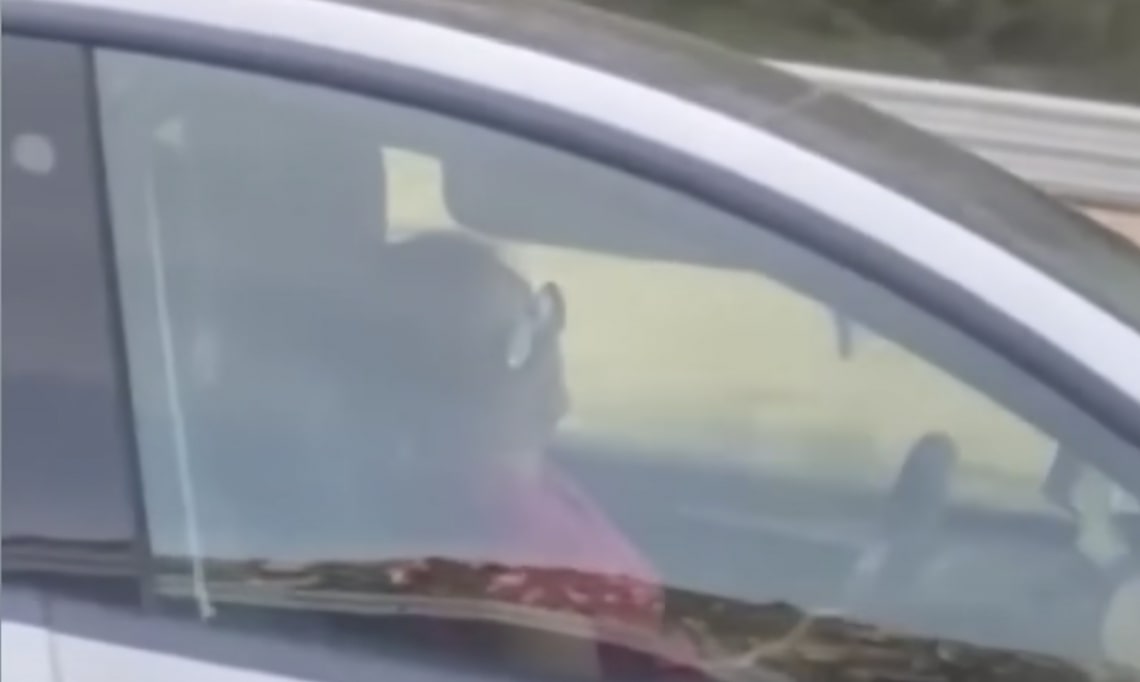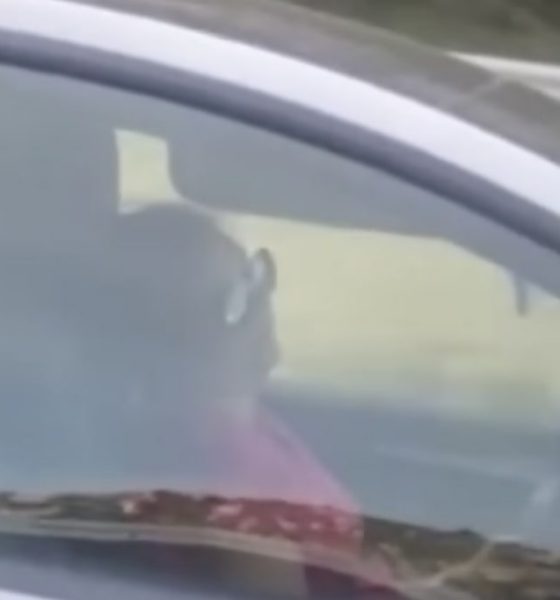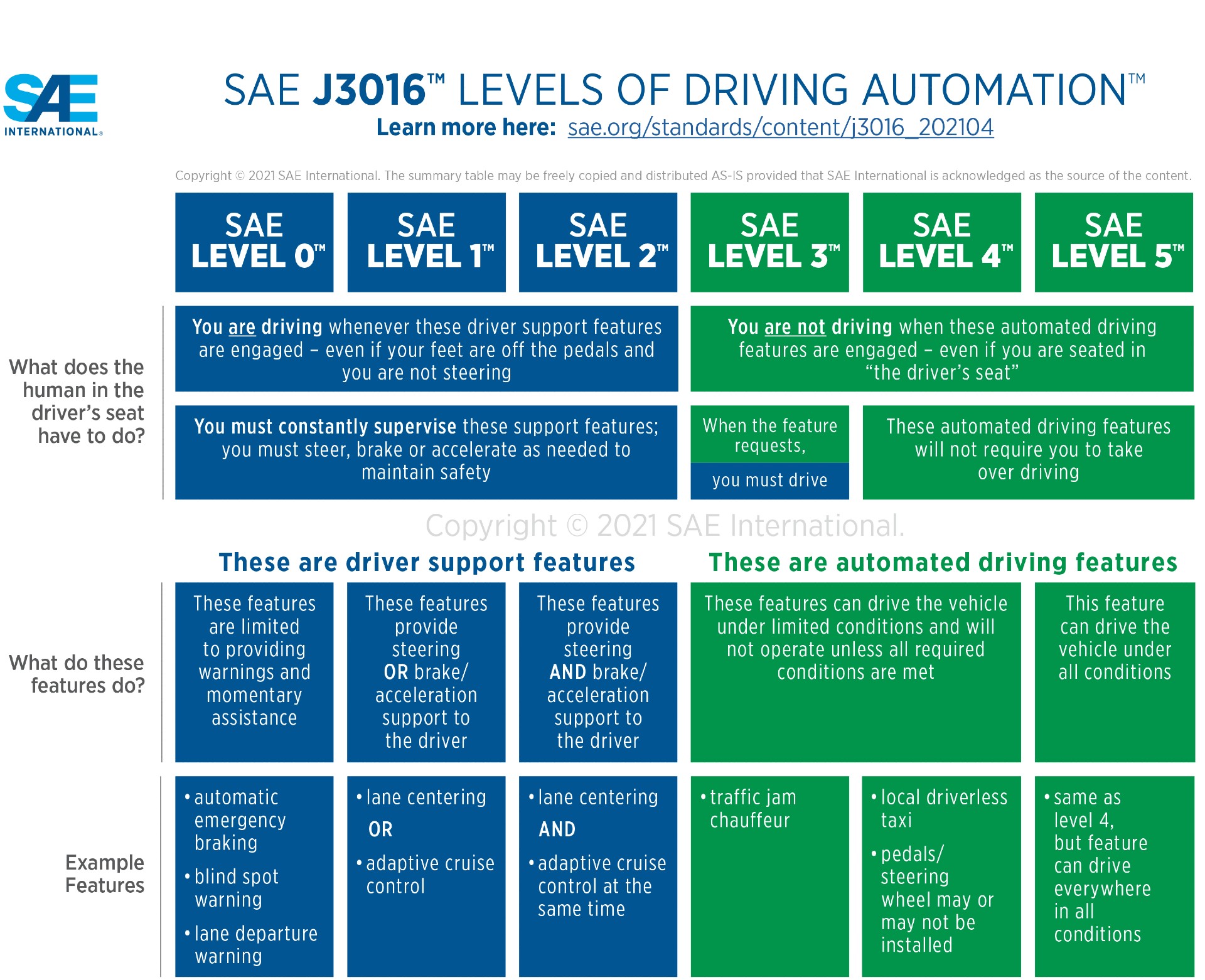

News
Tesla with sleeping driver proves there’s still misunderstanding and irresponsibility surrounding autonomy
Update: 11:06 AM EST: Paragraph 7 added to show the probability of the driver having a medical emergency. California Highway Patrol saw the vehicle and noted the driver was awake after catching up to the car.
A Tesla Model Y with a sleeping driver was recently spotted on the I-15 Freeway near Temecula, California, which proves that people and media still have a vast misunderstanding and irresponsible tone regarding the capabilities of semi-autonomous vehicles.
According to a report from KTLA 5, a woman in a Tesla Model Y was followed by another driver for more than fifteen minutes on the California interstate in an attempt to wake the woman who was taking advantage of the automaker’s semi-autonomous driving functions up.
The report and the incident prove there are still huge misunderstandings in the capabilities of semi-autonomous driving suites, including Tesla’s Full Self-Driving and Autopilot, which require users to remain vigilant and be prepared to take over the vehicle at any point.
Drivers utilize semi-autonomous vehicle functionalities irresponsibly often, and social media has proven time and time again that people take advantage of the capabilities, even though they are not fully autonomous.
It is no secret that people and companies have utilized whatever they can to alleviate themselves of the responsibility of paying attention while the car operates some tasks on its own. With the introduction of advanced driver assistance systems (ADAS) over the past several years, drivers have taken advantage of the functions to instead play on their phones, read books, eat food, or even catch up on sleep.
Tesla’s camera-based driver monitoring system goes through the cellphone test
However, the risks that come with this behavior are potentially catastrophic. For one, those who use these functions irresponsibly put themselves and every other driver on the road at risk because if the vehicle needs assistance or encounters a situation where it would not react safely, the driver is responsible for taking over. Additionally, if an accident occurs, it can be framed as Tesla’s, or any other manufacturer’s fault, depending on the vehicle used, and instances like this can set the future of semi-autonomous and autonomous driving back years due to skepticism.
There is the possibility that the driver had some type of medical emergency or accidentally fell asleep, in which the Tesla’s functionalities kept the operator and others safe. Police stated the driver was caught up to two minutes after receiving calls about the driver, and the driver was attentive at this time.
However, the media’s portrayal of the situation also proves that many are widely uninformed regarding the capabilities of Teslas. While Tesla’s Full Self-Driving suite has caused controversy over its name, the automaker continues to remind those who use it to remain vigilant, as the cars cannot truly drive themselves.
In Tesla’s FAQ section of the Autopilot and Full Self-Driving page, the company answers the question, “Do I still need to pay attention while using Autopilot?:”
“Yes. Autopilot is a hands-on driver assistance system that is intended to be used only with a fully attentive driver. It does not turn a Tesla into a self-driving car nor does it make a car autonomous.
Before enabling Autopilot, you must agree to “keep your hands on the steering wheel at all times” and to always “maintain control and responsibility for your car.” Once engaged, Autopilot will also deliver an escalating series of visual and audio warnings, reminding you to place your hands on the wheel if insufficient torque is applied. If you repeatedly ignore these warnings, you will be locked out from using Autopilot during that trip.
You can override any of Autopilot’s features at any time by steering, applying the brakes, or using the cruise control stalk to deactivate.”
Media labeling the vehicle as “a self-driving Tesla” is a disservice to people and the company. Teslas do not drive themselves, as the vehicles are defined as Level 2, according to the Society of Automotive Engineers Levels of Driving Automation. Level 2 systems reiterate that the driver is still responsible for driving the car when these systems are activated. “You must constantly supervise these support features,” the SAE says. Level 3 to Level 5 systems maintain that the operator is not driving the car, but Level 5 systems are the only ones that are explicitly labeled as “self-driving.”
“This feature can drive the vehicle under all conditions,” the SAE table states.
Credit: Society of Automotive Engineers
Recent ratings by Consumer Reports showed that Tesla’s biggest flaw was driver monitoring. Many systems use cabin-facing cameras to monitor eye behavior to ensure the operator is keeping their eyes on the road. Teslas use a series of audible and visual cues to alert drivers of their inattentiveness, and steering wheel sensors make sure the driver keeps their hands on the wheel.
However, various cheat devices have been marketed across the internet, and in this instance, the driver appears to have their hands on the wheel while they are dozed.
Tesla activated camera-based driver monitoring in May 2021. “The cabin camera above your rearview mirror can now detect and alert driver inattentiveness while Autopilot is engaged,” Tesla said in the notes. Tests of Tesla’s driver monitoring tests showed the system was effective in some instances, especially when looking at cell phones, with alerts coming in 15 seconds.
The potential irresponsibility of users puts major risks to those on the road and the companies that develop these driver assistance programs. While there are workarounds through the previously-mentioned cheat devices, people have to know their irresponsibility could cost them, or others, their lives.
I’d love to hear from you! If you have any comments, concerns, or questions, please email me at joey@teslarati.com. You can also reach me on Twitter @KlenderJoey, or if you have news tips, you can email us at tips@teslarati.com.

News
Tesla FSD fleet is nearing 7 billion total miles, including 2.5 billion city miles
As can be seen on Tesla’s official FSD webpage, vehicles equipped with the system have now navigated over 6.99 billion miles.

Tesla’s Full Self-Driving (Supervised) fleet is closing in on almost 7 billion total miles driven, as per data posted by the company on its official FSD webpage.
These figures hint at the massive scale of data fueling Tesla’s rapid FSD improvements, which have been quite notable as of late.
FSD mileage milestones
As can be seen on Tesla’s official FSD webpage, vehicles equipped with the system have now navigated over 6.99 billion miles. Tesla owner and avid FSD tester Whole Mars Catalog also shared a screenshot indicating that from the nearly 7 billion miles traveled by the FSD fleet, more than 2.5 billion miles were driven inside cities.
City miles are particularly valuable for complex urban scenarios like unprotected turns, pedestrian interactions, and traffic lights. This is also the difference-maker for FSD, as only complex solutions, such as Waymo’s self-driving taxis, operate similarly on inner-city streets. And even then, incidents such as the San Francisco blackouts have proven challenging for sensor-rich vehicles like Waymos.
Tesla’s data edge
Tesla has a number of advantages in the autonomous vehicle sector, one of which is the size of its fleet and the number of vehicles training FSD on real-world roads. Tesla’s nearly 7 billion FSD miles then allow the company to roll out updates that make its vehicles behave like they are being driven by experienced drivers, even if they are operating on their own.
So notable are Tesla’s improvements to FSD that NVIDIA Director of Robotics Jim Fan, after experiencing FSD v14, noted that the system is the first AI that passes what he described as a “Physical Turing Test.”
“Despite knowing exactly how robot learning works, I still find it magical watching the steering wheel turn by itself. First it feels surreal, next it becomes routine. Then, like the smartphone, taking it away actively hurts. This is how humanity gets rewired and glued to god-like technologies,” Fan wrote in a post on X.
News
Tesla starts showing how FSD will change lives in Europe
Local officials tested the system on narrow country roads and were impressed by FSD’s smooth, human-like driving, with some calling the service a game-changer for everyday life in areas that are far from urban centers.

Tesla has launched Europe’s first public shuttle service using Full Self-Driving (Supervised) in the rural Eifelkreis Bitburg-Prüm region of Germany, demonstrating how the technology can restore independence and mobility for people who struggle with limited transport options.
Local officials tested the system on narrow country roads and were impressed by FSD’s smooth, human-like driving, with some calling the service a game-changer for everyday life in areas that are far from urban centers.
Officials see real impact on rural residents
Arzfeld Mayor Johannes Kuhl and District Administrator Andreas Kruppert personally tested the Tesla shuttle service. This allowed them to see just how well FSD navigated winding lanes and rural roads confidently. Kruppert said, “Autonomous driving sounds like science fiction to many, but we simply see here that it works totally well in rural regions too.” Kuhl, for his part, also noted that FSD “feels like a very experienced driver.”
The pilot complements the area’s “Citizen Bus” program, which provides on-demand rides for elderly residents who can no longer drive themselves. Tesla Europe shared a video of a demonstration of the service, highlighting how FSD gives people their freedom back, even in places where public transport is not as prevalent.
What the Ministry for Economic Affairs and Transport says
Rhineland-Palatinate’s Minister Daniela Schmitt supported the project, praising the collaboration that made this “first of its kind in Europe” possible. As per the ministry, the rural rollout for the service shows FSD’s potential beyond major cities, and it delivers tangible benefits like grocery runs, doctor visits, and social connections for isolated residents.
“Reliable and flexible mobility is especially vital in rural areas. With the launch of a shuttle service using self-driving vehicles (FSD supervised) by Tesla in the Eifelkreis Bitburg-Prüm, an innovative pilot project is now getting underway that complements local community bus services. It is the first project of its kind in Europe.
“The result is a real gain for rural mobility: greater accessibility, more flexibility and tangible benefits for everyday life. A strong signal for innovation, cooperation and future-oriented mobility beyond urban centers,” the ministry wrote in a LinkedIn post.
News
Tesla China quietly posts Robotaxi-related job listing
Tesla China is currently seeking a Low Voltage Electrical Engineer to work on circuit board design for the company’s autonomous vehicles.

Tesla has posted a new job listing in Shanghai explicitly tied to its Robotaxi program, fueling speculation that the company is preparing to launch its dedicated autonomous ride-hailing service in China.
As noted in the listing, Tesla China is currently seeking a Low Voltage Electrical Engineer to work on circuit board design for the company’s autonomous vehicles.
Robotaxi-specific role
The listing, which was shared on social media platform X by industry watcher @tslaming, suggested that Tesla China is looking to fill the role urgently. The job listing itself specifically mentions that the person hired for the role will be working on the Low Voltage Hardware team, which would design the circuit boards that would serve as the nervous system of the Robotaxi.
Key tasks for the role, as indicated in the job listing, include collaboration with PCB layout, firmware, mechanical, program management, and validation teams, among other responsibilities. The role is based in Shanghai.
China Robotaxi launch
China represents a massive potential market for robotaxis, with its dense urban centers and supportive policies in select cities. Tesla has limited permission to roll out FSD in the country, though despite this, its vehicles have been hailed as among the best in the market when it comes to autonomous features. So far, at least, it appears that China supports Tesla’s FSD and Robotaxi rollout.
This was hinted at in November, when Tesla brought the Cybercab to the 8th China International Import Expo (CIIE) in Shanghai, marking the first time that the autonomous two-seater was brought to the Asia-Pacific region. The vehicle, despite not having a release date in China, received a significant amount of interest among the event’s attendees.








